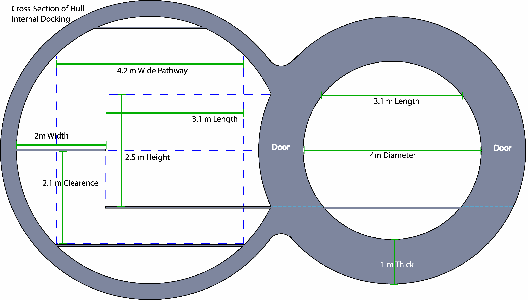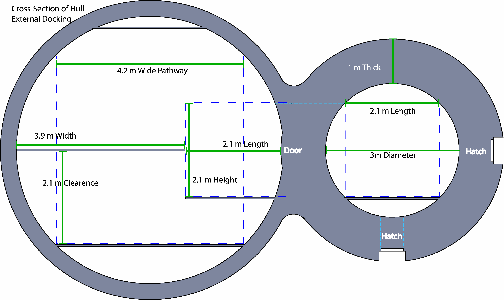 |
Atlantis II Docking Systems
 The Atlantis II uses both internal and external docking systems to satisfy its needs. Each docking system manifests as a sphere flush with the side of the torus of the habitat. The Atlantis II uses both internal and external docking systems to satisfy its needs. Each docking system manifests as a sphere flush with the side of the torus of the habitat.

 The internal docking system is used in the larger of the two docking spheres. The system is called an internal system because it allows the entire vehicle to enter the habitat. This feature is useful to the robotics equipment because it allows technicians to modify, repair, and upgrade a piece of equipment on site rather than taking it all the way back to land. The internal docking system is also useful because it allows samples to be brought inside the Atlantis II for study by the scientists on board. The 4 m diameter sphere and 2.5 m diameter door are designed to accommodate the larger ROV's used and still have enough room for equipment to remove the robot from the sphere. The internal docking system is used in the larger of the two docking spheres. The system is called an internal system because it allows the entire vehicle to enter the habitat. This feature is useful to the robotics equipment because it allows technicians to modify, repair, and upgrade a piece of equipment on site rather than taking it all the way back to land. The internal docking system is also useful because it allows samples to be brought inside the Atlantis II for study by the scientists on board. The 4 m diameter sphere and 2.5 m diameter door are designed to accommodate the larger ROV's used and still have enough room for equipment to remove the robot from the sphere.
 The internal docking system is basically an airlock; by pressurizing and depressurizing the contents of the docking sphere, it allows the contents to switch between the 300 atmosphere pressure outside the habitat and the 1 atmosphere pressure inside the habitat. The internal docking system is basically an airlock; by pressurizing and depressurizing the contents of the docking sphere, it allows the contents to switch between the 300 atmosphere pressure outside the habitat and the 1 atmosphere pressure inside the habitat.
 The sphere is pressurized by slowly bleeding water from the outside into the sphere over space of thirty minutes. Once the sphere is completely filled with water, the outside door can then be opened, allowing access to the outside. The sphere is depressurized by using a set of high powered pumps built into the base of the sphere to suck out the water at the same time as air from inside the habitat is bled into the top of the sphere. It takes approximately 2 hours for the pumps to remove all of the water. At this point the internal door can be opened, allowing access to the habitat. The sphere is pressurized by slowly bleeding water from the outside into the sphere over space of thirty minutes. Once the sphere is completely filled with water, the outside door can then be opened, allowing access to the outside. The sphere is depressurized by using a set of high powered pumps built into the base of the sphere to suck out the water at the same time as air from inside the habitat is bled into the top of the sphere. It takes approximately 2 hours for the pumps to remove all of the water. At this point the internal door can be opened, allowing access to the habitat.

 The external docking system is incorporated into the sphere diametrically opposite the internal docking sphere. It's slightly smaller since it doesn't need to accommodate vehicles; it is instead designed for the standard 2.1 m clearance used throughout the Atlantis II. The system is considered an external system because the docked vehicle remains outside the habitat. The advantages of such a system is that the docked vehicle can be quite large, the docking mechanism takes up a smaller volume, and the docking process is much faster. The external docking system is reserved for docking with the LEEAMITe (Transportation vehicle) and the EVE (Manned Operations vehicle). To accommodate both vehicles at once, there are two docking points on the sphere, one on the side (LEEAMITe's) and one on the bottom (EVE's). Each point is a 0.5 m diameter hatch sunk 30 cm into the hull of the sphere, creating a cylindrical hole 0.6 m in diameter and 30 cm deep. There is also a small protusion around the docking point about 25 cm into hole and a pair of small water inlet valves, one set in the center of the hatch and another in the hull (see diagram). The matching mechanism on the two vehicles is a cylinder approximately 30 cm long and just slightly thinner than the hole in the docking sphere. The external docking system is incorporated into the sphere diametrically opposite the internal docking sphere. It's slightly smaller since it doesn't need to accommodate vehicles; it is instead designed for the standard 2.1 m clearance used throughout the Atlantis II. The system is considered an external system because the docked vehicle remains outside the habitat. The advantages of such a system is that the docked vehicle can be quite large, the docking mechanism takes up a smaller volume, and the docking process is much faster. The external docking system is reserved for docking with the LEEAMITe (Transportation vehicle) and the EVE (Manned Operations vehicle). To accommodate both vehicles at once, there are two docking points on the sphere, one on the side (LEEAMITe's) and one on the bottom (EVE's). Each point is a 0.5 m diameter hatch sunk 30 cm into the hull of the sphere, creating a cylindrical hole 0.6 m in diameter and 30 cm deep. There is also a small protusion around the docking point about 25 cm into hole and a pair of small water inlet valves, one set in the center of the hatch and another in the hull (see diagram). The matching mechanism on the two vehicles is a cylinder approximately 30 cm long and just slightly thinner than the hole in the docking sphere.
 The system takes advantage of the enormous pressure to accomplish the connection. First, the pilot maneuvers the vehicle so that the two pieces fit together. At this point, the valve in the hatch is opened, letting water into the docking sphere. The incoming water quickly sucks the vehicle to the lip, sealing the connection by virtue of the 300 atmospheres of pressure. The hatches can then be opened, allowing entry into the habitat. The system takes advantage of the enormous pressure to accomplish the connection. First, the pilot maneuvers the vehicle so that the two pieces fit together. At this point, the valve in the hatch is opened, letting water into the docking sphere. The incoming water quickly sucks the vehicle to the lip, sealing the connection by virtue of the 300 atmospheres of pressure. The hatches can then be opened, allowing entry into the habitat.
 The inlet water can then be pumped back out through the internal docking sphere. When the vehicle wishes to undock, it has to neutralize the pressure holding the connection. First, the two hatches are closed and the inlet valve is secured. The second valve is the opened, flooding the gap between the habitat and the vehicle. The vehicle is then free to depart. The inlet water can then be pumped back out through the internal docking sphere. When the vehicle wishes to undock, it has to neutralize the pressure holding the connection. First, the two hatches are closed and the inlet valve is secured. The second valve is the opened, flooding the gap between the habitat and the vehicle. The vehicle is then free to depart.
|















